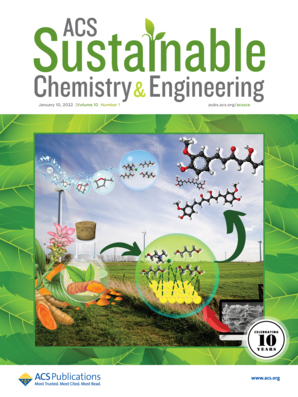农业废弃物-生物炭(从废水中回收磷酸盐)-土壤(缓释磷肥)-植物(花生生长)系统:经济和环境可持续战略
IF 7.3
1区 化学
Q1 CHEMISTRY, MULTIDISCIPLINARY
引用次数: 0
摘要
传统磷肥的过量使用导致过量磷通过淋滤、挥发、农业径流等方式进入环境,造成富营养化、土壤退化、磷资源枯竭等一系列问题。因此,从废水中回收磷对生态保护和农业可持续发展至关重要。本文提出并设计了一种有效的钙修饰多孔生物炭(CEBC)合成策略,用于含磷废水中磷的回收,并将其作为缓释磷肥应用。CEBC具有良好的磷酸盐回收性能,最大吸附量为193.93 mg P/g。此外,缓释试验表明,在24 h内,载磷生物炭基缓释肥(CEBC-P)的养分释放率为8.95%。施用CEBC-P后,花生总生物量积累和净光合速率分别提高了2.54倍和4.91倍。机理研究表明,磷酸盐通过沉淀、配位、氢键和静电吸引被保留在生物炭中。此外,释放动力学最符合Peppas-Sahlin模型(R2 = 0.996),表明CEBC-P的养分释放受扩散和溶解的协同作用。总体而言,本研究为磷资源的回收和循环利用提供了经济和环境可持续的策略。本文章由计算机程序翻译,如有差异,请以英文原文为准。

Agricultural Waste–Biochar (Reclaiming Phosphate from Wastewater)–Soil (Slow-Release Phosphate Fertilizer)–Plant (Peanut Growth) System: Economical and Environmentally Sustainable Strategy
Excessive use of traditional phosphate fertilizers has led to excess phosphorus entering the environment through leaching, volatilization, and agricultural runoff, causing a series of problems such as eutrophication, soil degradation, and phosphorus resource exhaustion. Therefore, the reclamation of phosphorus from wastewater is essential for ecological protection and sustainable agricultural development. Herein, an effective strategy for the synthesis of calcium-modified porous biochar (CEBC) was provided and designed for the recovery of phosphorus from phosphorus-containing wastewater, followed by its application as a slow-release phosphorus fertilizer. CEBC exhibited an excellent phosphate recovery performance with a maximum adsorption capacity of 193.93 mg P/g. Furthermore, slow-release experiments demonstrated that the nutrient release rate of phosphorus-loaded biochar-based slow-release fertilizer (CEBC-P) was 8.95% within 24 h. After application of CEBC-P, the total biomass accumulation and net photosynthetic rate of peanuts increased by 2.54-fold and 4.91-fold, respectively. Mechanistic studies revealed that phosphate was retained within the biochar through precipitation, coordination, hydrogen bonding, and electrostatic attraction. Moreover, release kinetics optimally fitted the Peppas–Sahlin model (R2 = 0.996), suggesting that the nutrient release from CEBC-P was synergized by diffusion and dissolution. Overall, this study provides an economical and environmentally sustainable strategy for the recovery and recycling of phosphorus resources.
求助全文
通过发布文献求助,成功后即可免费获取论文全文。
去求助
来源期刊

ACS Sustainable Chemistry & Engineering
CHEMISTRY, MULTIDISCIPLINARY-ENGINEERING, CHEMICAL
CiteScore
13.80
自引率
4.80%
发文量
1470
审稿时长
1.7 months
期刊介绍:
ACS Sustainable Chemistry & Engineering is a prestigious weekly peer-reviewed scientific journal published by the American Chemical Society. Dedicated to advancing the principles of green chemistry and green engineering, it covers a wide array of research topics including green chemistry, green engineering, biomass, alternative energy, and life cycle assessment.
The journal welcomes submissions in various formats, including Letters, Articles, Features, and Perspectives (Reviews), that address the challenges of sustainability in the chemical enterprise and contribute to the advancement of sustainable practices. Join us in shaping the future of sustainable chemistry and engineering.
 求助内容:
求助内容: 应助结果提醒方式:
应助结果提醒方式:


